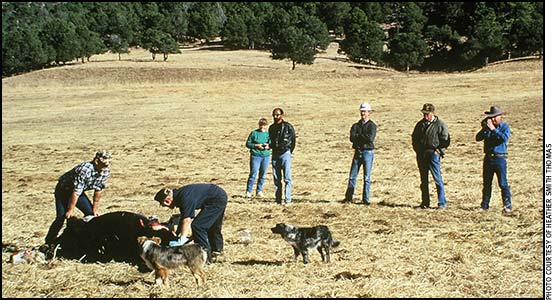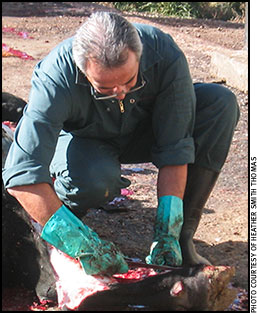
David Van Metre, associate professor and extension veterinarian at Colorado State University, says necropsy on a dead animal can be helpful in many instances.
Benefits of Being Able to Perform a Necropsy
Veterinarians can serve as educators for stockmen.
If an animal dies and the cause of death is unknown, it’s often wise to perform a necropsy to try to determine what happened, especially if a change in management could eliminate the risk for further deaths in the herd. A postmortem examination might determine whether the animal died from hardware, pneumonia, poisoning or some other problem that might be preventable. If there’s a disease in the herd, a parasite problem or nutritional deficiency that the producer has not been aware of, a necropsy can be a useful tool for helping solve a problem and finding ways to improve health management.
David Van Metre, associate professor and extension veterinarian at Colorado State University, says that being a university hospital-based clinician sometimes makes it difficult to formulate prevention strategies when he only sees sick animals at the clinic and a dead calf now and then.

“We have a saying that the most valuable animal on your property is the one that just died, because there is much to learn from a necropsy, such as what it died from, or the efficacy of treatments that were applied,” Van Metre says.
Necropsy on a dead animal can be helpful in many instances, however. He says, “We have a saying that the most valuable animal on your property is the one that just died, because there is much to learn from a necropsy, such as what it died from, or the efficacy of treatments that were applied.”
If it died suddenly, rather than from a chronic disease, the animal’s tissues might also be harvested and used for nutrient analysis, such as copper levels, for example, especially if it was put down for something like an injury such as a broken leg.
Veterinarians who service large outfits and feedlots often show clients how necropsies are performed, and point out different disease processes. This can be very educational. For example, the stockman can understand why the antibiotic treatment for a chronic pneumonia is far less likely to succeed than if it were administered in the first or second day of illness.
“There will be scarring and abscess formation in a chronic pneumonia. Some of these processes are hard to understand until you see this with your own eyes, and realize that this animal was never going to get better because 80% of the lung tissue is destroyed. It’s one thing to talk about chronics, but seeing what’s going wrong in the lung can be very informative,” explains Van Metre.
“We in academia need to push this level of training onto our new graduates, stressing the need to be educators, able to explain and demonstrate these things to stockmen. The vast majority of people who are ranching want to do a good job; they want to raise healthy animals and are willing to learn. What we need to fill, on our side of the obligation, is to have the capacity to teach. Showing stockmen how to do a basic necropsy can be very helpful to our clients.”
Ranchers who experience problems should ask their veterinarian to teach them what to look for, and how to collect tissue samples for their vet to examine or to send to a laboratory for further diagnostics.

Editor’s Note: Heather Smith Thomas is a cattlewoman and freelance writer from Salmon, Idaho.






